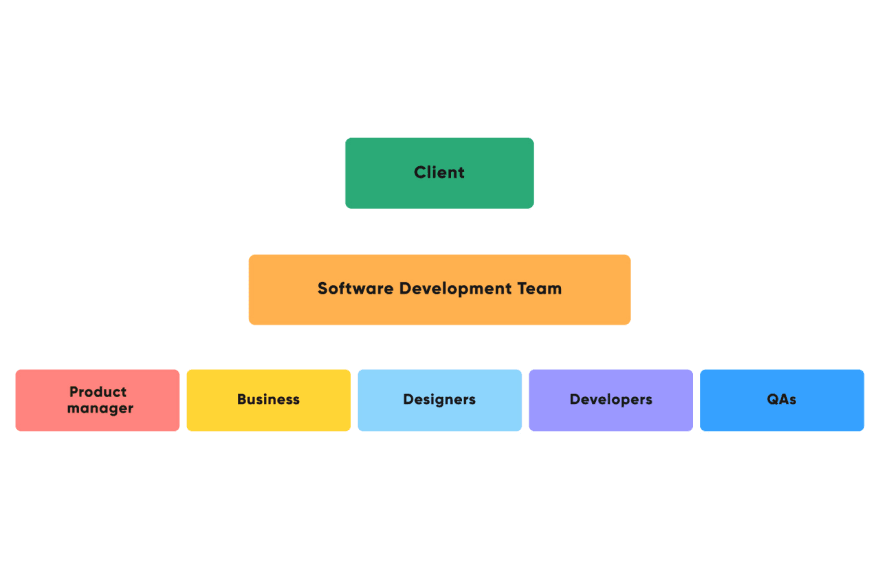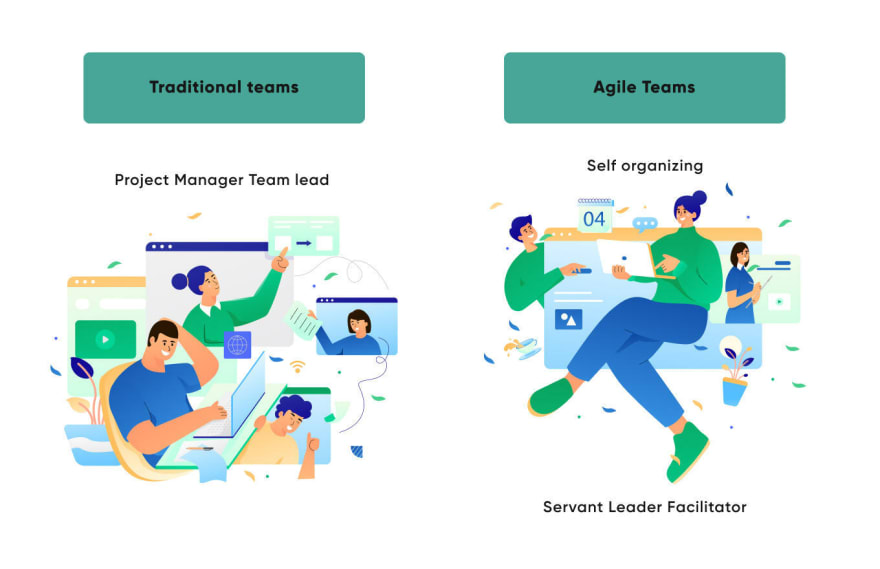The original article was written by SoftFormance https://www.softformance.com/blog/agile-team-structure/
I have already introduced you to the practice of Agile and its core principles in the previous article. We have discussed the Agile development process at SoftFormance and talked about the key reasons to choose an Agile team.
Now, it’s high time to talk about the people involved in Agile because this process wouldn’t be as effective without them. The fast and successful results achieved through Agile are the merit of each member of the team, their coordinated work, and constant cooperation.
If you want to implement Agile software development practice in your organization, the next step after learning about its principles would be to establish the team roles and find the right specialists to perform the tasks.
One thing you need to remember is that Agile is an abstract model. As a result, there is no precise plan on how to form an Agile team – everything depends on your specific situation. Some organizations prefer to divide the roles by skills and choose a complete generalist approach, others prefer working with specialists.
To help you better understand how Agile teams work, I will focus on our SoftFormace team, our roles when working on clients’ projects, and how we have improved on our Agile team structure in software engineering.
If you want to receive twice as great results in the shortest period while saving money, keep on reading this article, and I’ll tell you how to create an efficient Agile development team.
Approaches to product team structure
The arrangement of an Agile team depends on many factors – the scope of your project, your requirements, deadlines, and so on. There is no universal way to create a team that will work for every single organization and every project.
Still, there are three main approaches to choose from that will help you decide which path to follow. These approaches are:
- Generalist
- Specialist
- Hybrid

Generalist approach
Choose this approach if you want the team members to have many different responsibilities instead of focusing on one limited area. With this approach, you choose individuals with a broad set of skills, ready to perform tasks of any kind.
This is the most common team structure when working with third-party development teams. Usually, generalist teams in software development work on one individual feature of the project or are responsible for the end-to-end development of the entire project.
What are the benefits of this approach?
Each member of the team has enough skills and is competent enough to complete their tasks without any assistance and dependency on other members of the team
All people in the team have a clear understanding of the product, and it allows them to work on its improvement
However, this approach also has a disadvantage that frequently discourages business owners from choosing it.
Mainly, teams created with this approach consist of people without specific knowledge. As a result, the team lacks specialists who can either help onboard new members or solve some specific issues.
Specialist approach
Unlike the previous approach, specialist teams consist of experts with extra-specific sets of skills and knowledge. Each member performs precise tasks they’re proficient in.
It’s a perfect approach for complex projects when you need your team to perform perfectly, or else you will lose both time and money.
When you choose the specialist approach – you make sure that all problems are tackled by experts, and there’s no need to worry that some issues won’t be addressed.
The pros of the specialist approach:
Complex projects are finished quicker
Ability to address the most specific problems
Specific knowledge of all project elements
The cons:
All members are working individually, that’s why sometimes adjustments to the components are needed
Possible issues with communication since there’s no shared general knowledge
Hybrid approach
This approach is a combination of the previous two. Hybrid teams work on the projects as a whole, but they can apply specific knowledge and narrow down their focus if needed. It’s a perfect combo that allows you to work on any kind of Agile project.
Advantages of a hybrid approach:
Maximum efficiency of the development process
Flexibility and ability to shift focus from general to specific tasks
Teams consist of both specialists and generalists
Disadvantages:
Building this team can be expensive and time-consuming
Can be challenging to coordinate the team and work with people who have different approaches and skills
Software development team structure
Before talking about the Agile team structure, let’s recollect what a typical software development team structure looks like. I have already explained it in detail here so if you want to learn more, read that article first.
When we think of an ideal team, it consists of both generalists and specialists, and they communicate and collaborate easily. However, due to time constraints, budgeting issues, and other factors, it’s not possible. That’s why most teams these days choose a generalist structure.
What does it look like?

Project Manager (PM)
A project manager of your team is responsible for the planning and execution part of the project. This person takes into account all client demands and technical implications to deliver a perfect final product.
PMs also take care of building relationships between the client and different departments of the organization. They manage the processes, assign tasks to the members of the team, and ensure that all deadlines are met.
Business Analyst (BA)
BAs are in charge of creating a roadmap of how to build your particular project and how to make it practical. This person determines the features that would be perfect for your product taking into account the trends in the market and your specific demands.
A BA should also analyze what would work in the future and what direction for your business to establish. In other words, business analysts have foresight.
UI/UX Designer
UI/UX designers are responsible for the aesthetic and the functional part of your product’s interface. We have already talked about product design in detail here, if you want to learn more about that part of product development.
Designers’ main aim is to make your product visually appealing with the right use of colors, shapes, and other elements. Apart from the visual part, UX designers ensure that your product is highly-functional.
Developers
The team of developers is in charge of building the actual product. There are back-end, front-end, and full-stack developers.
Back-end developers work with the app’s server-side. They work with the fundamental part of the product, its “walls.”
Front-end developers work on the visible elements of the product, its exterior. Their aim is to make it attractive and pleasing to look at.
Full-stack developers combine the best of both worlds. They handle every task in software development, both the fundamental parts of app building and its exterior parts.
Quality Assurance Engineer (QA)
QAs test the product before its release to ensure its functionality. They make sure that the product meets the expectations and the requirements of the client.
These specialists help you fix any issues or bugs that your product has and make sure that the final product is flawless.
Agile team structure
In the typical software development team structure, the focus is on the person’s job title and what they specialize in. In the Agile team, the focus is on the team member’s set of skills.
The roles can vary depending on what methodology you choose. For instance, in a Scrum environment, the roles are clearly prescribed. In Kandan teams there are no roles as their goal is to make the environment as flexible and fluid as possible.
However, there still are a couple of Agile team roles that are most frequently used in Scrum. They include a Product Owner, a Scrum Master, and a Development team.

Product Owner (PO)
A PO is responsible for developing and communicating the Product Goal, communicating Product Backlog items, ordering them, and making sure that the process is transparent and understood by every member of the team.
A Product Owner represents the needs of the client. That is why it is so important that this person regularly communicates with the team, offers guidance, and informs them about what needs to be changed or added.
Team Lead
A team lead is responsible for coordinating the team. This person ensures that all processes run smoothly, deadlines are met, and everyone understands their tasks clearly. A team lead organizes incoming requests, monitors workflows, and hosts meetings. Finally, they ensure that the team follows the Agile Manifesto.
Development team
Just like in a traditional software team structure, this team consists of back-end, front-end, and full-stack developers, but it also includes UI/UX designers and QA testers. All of them constantly collaborate and work on the project together.
Traditional team VS Agile team
The main difference between the traditional and Agile teams is in the type of cooperation. In Agile teams, all team members closely collaborate with each other, and there are no precise roles that focus on people’s job titles.
Traditional Team:
- All responsibility is on the project manager.
- Can work on several projects at the same time.
- Individual performance is important.
- No size limit.
- Focus on job titles.
Agile Team:
- The team is self-organized and self-managed.
- Focuses on one project at a time.
- Team performance is more important.
- A team of 3-9 people.
- Focus on skills rather than titles.
Agile Team Key Characteristics
For your project to be successful and competitive on the market, you need it to be completed not just by any team. You need the best team possible. You need to build a team of motivated and driven people who are interested in the success of your project and put all their knowledge and skills into the work.
Skills are not the only factor you need to consider when building a team. You also need to make sure that your team is:
Cross-functional
All team members should have sufficient knowledge in all aspects of product development: UI/UX, integration, QA, etc. The main idea here is that the team should be able to collaborate throughout the entire process of development, complement each other’s skills, and help each other out. However, it can only work if you have a small team.
Self-managing
An Agile team does not have a project manager responsible for most processes in the team. Instead, it is self-managing and self-organized. Each member of the team equally contributes to the tasks and ensures that all deadlines are met. The teams are not organized hierarchically. Instead, the focus is on joint effort and equality. If we’re talking about Scrum, then the Scrum master ensures that everyone follows the four Scrum ceremonies properly.
Co-located or Distributed
It is easy for the team to communicate and constantly cooperate if the members are at the same location. However, if your team members are distributed across the globe, it can become challenging. The key to success is in proper preparation and the tools used. Choose a team that uses various planning tools, schedules regular Zoom calls, and constantly stays in touch.
Dedicated
In a dedicated team, all team members work exclusively on one project. You don’t want them to get distracted and miss deadlines because of a huge overload on their other projects. Make sure that all members of your team are dedicated to the success of your project and put all their knowledge and effort into it. A dedicated team consists of focused and motivated individuals who can self-manage and take responsibility for the success of the project.
Long-lived
Look for a team that has been working together for quite some time or else they would need time for adjustment.
If you take all this into account and choose a perfect Agile team for your project, you will only benefit from it in the long run. Let’s learn about the main advantages of working with this type of team.
Benefits from having Agile Software Development Team
If all members of your team are following the Agile manifesto, are equally interested in the success of your project, and all collaborating effectively – you will definitely experience all these benefits from having an Agile software development team.
Common goal
One of the main benefits of working with a development team in Agile is that everyone is focused on one common goal, and there are no distractions in the form of other side projects. Team members don’t just make sure that their part is done. They work hand-in-hand, collaborate, share their experiences, and are constantly learning.
Good communication
Any teamwork wouldn’t be effective without communication, and an Agile team is no exception. Here, communication is important because the delivery of the product is dependent on each team member. It is essential to address any issues immediately, inform of any blockers, and discuss matters constantly.
Strong team culture
The principles and values of Agile are clearly defined in the Agile manifesto, and it influences the team culture. All members are goal-oriented and dedicated to the success of the project. Furthermore, they value mutual respect, and support, and are always ready to help each other.
Better product quality
When you work with an Agile team, quality testing is performed all throughout the development process, and it helps eliminate any serious issues in the future. Moreover, it increases the quality of the final product, and it is more likely to meet all market requirements. Better quality is also achieved through constant feedback and communication.
Flexibility
Agile teams are incredibly adaptive and responsive to change. They are able to make adjustments along the way and accept new clients’ requirements. The team is always ready to accept and react to the client’s feedback and make changes to the project. The Agile team needs less time to adapt and is more flexible than typical development teams. This flexibility helps clients save time and money and receive a product that meets all their expectations and requirements.
Saved expenses
Working with an outsourced Agile team is not cheap, so don’t expect to receive flawless results for anything. However, the Agile team will definitely help you save a lot of money that could be wasted due to miscommunication, numerous changes at the end of the project, and even restarting the project from scratch.
SoftFormance Team Structure
At SoftFormance, we use the Agile team structure yet only partly. Let me explain.
We support the idea that all members of the team should constantly communicate with each other and cooperate for better results. Moreover, it is essential that your development team is fully dedicated to your project and its success.
Just like Agile teams, our software development team members always stay in touch with each other, the client, and the project manager. They react instantly to feedback and make changes to the project when needed.
However, we believe that members of the team cannot be chosen merely based on their skills. You need a team of specialists, each performing a specific task: DevOps, designers, QAs, etc. A designer can’t do the job of a developer, and a developer cannot perform BAs tasks.
That’s why our teamwork is a mix of Scrum and our clients’ needs and project requirements. We adapt our methodology to each individual case and choose a team structure that will bring about the best results for our clients.
Our programmers are experts in Python/Django and math, but they also are generalists in front-end and DevOps. As you can see, we prefer to work with full-stack developers. This way, it’s much easier to work on projects, finish them on time and within budget, and speed up the MVP release.
Our managers are also generalists. They are awesome at what they are doing but they also understand the basics of the related fields. For example, our manager can also perform the roles of a BA and a QA.
The mix of Scrum and our own approach helps us deliver the greatest results to our clients, meet their individual needs and expectations, and ensure that their projects are competitive in the current market.
Wrapping Up
The Agile team structure is all about the wise use of resources. Each member fits perfectly in this structure and is essential to the success of the project. As a result, working with an Agile software development team saves you time, and money, and results in faster delivery of a high-quality product.
At SoftFormance, we believe that team roles matter, and that’s why our team structure is a mix of Scrum and an individual approach to each client. We value skills but prefer to work with specialists who know their field the best.
If you have been looking for a team to build your software, but you can’t afford to waste time, money, and other resources, it’s high time to consider choosing an Agile development team.
Contact us if you have any questions or would like to discuss your future project.




Top comments (0)